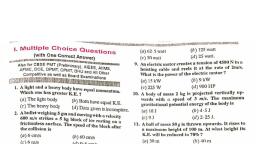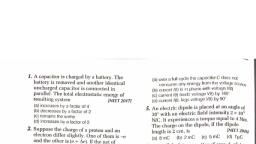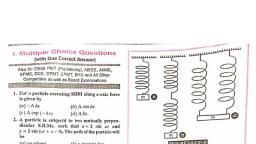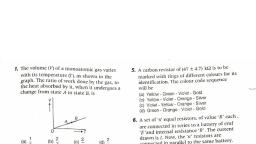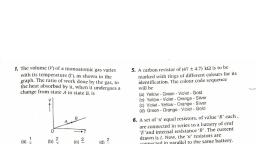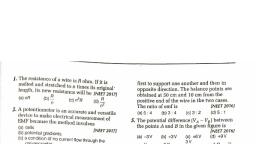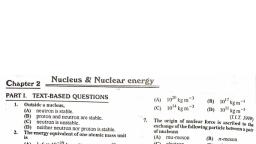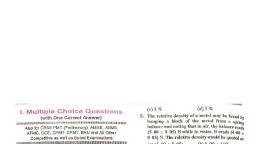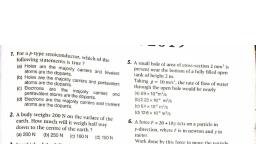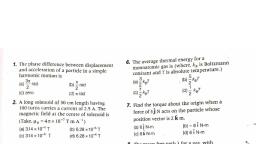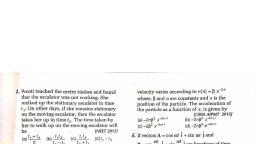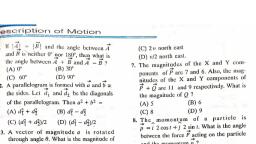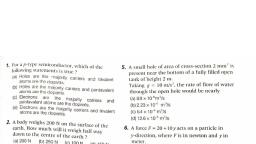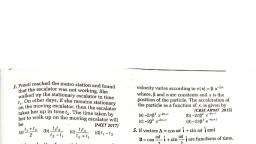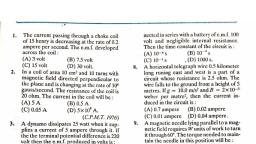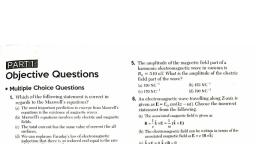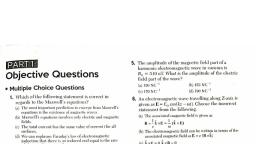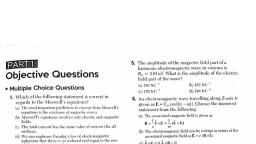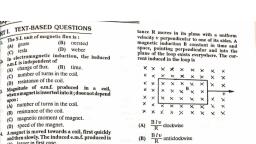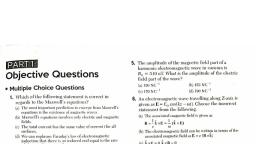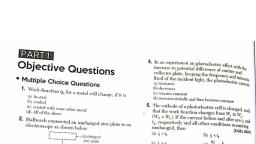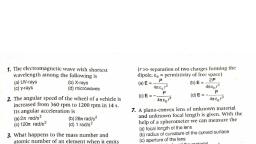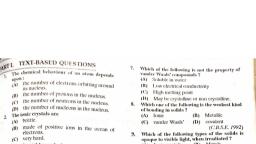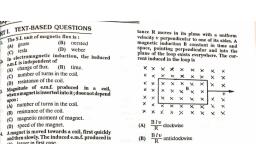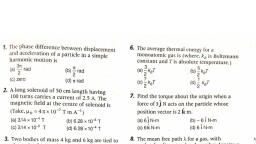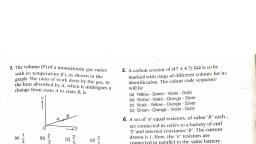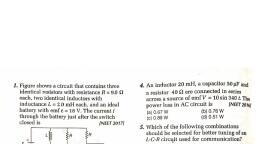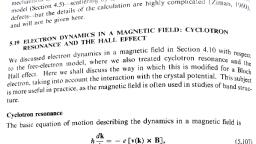Page 1 :
Objective Questions, , ¢ Multiple Choice Questions, , 1. Which of the following statement is correct in, , regards to the Maxwell's equations?, , (a) The most important preiiction to emerge from Maxwell's, equations ts the existence of magnetic, , th) Maxwell's equations invelves only clectric and magnetic, fields., , {e) The total current has the same value of current ifor all, surfaces,, , {d) We can rephrase Faraday’s law of clectromarnetic, induction that there is wn induced emf equal to the rate, of change of magnetic Mus., , , , 2. The electric field of an electromagnetic wave, travelling through vacuum is given hy the equation, E= Ky sin (kx et}. The quantity that is, independent of wavelength is, , fa) th) ke, «, , fe} {dk, 3. The electric and the magnetic fields, associated, with an electromagnetic wave, propagating along, the + Y-axis, can be represented by, (a) (E« Ky k, B= Byi), (b)(E=E, jp B= By i), ()( = Ey j, B= By k), (@)(E = Fy i, B= By 1), 4. Light wave is travelling along y-direction. If the, , corresponding E vector at any time is along the, X-axis, the dircetion of B vector at that time is along, , 0, , , , , , (b) X-axis, , fa) Y-axis (a) -Z-uals, , {c} + Z-axis, , 5. The amplitude of the magnetic field part of a, harmonic electromagnetic wave in vacuum is, By = 510 nl. What is the amplitude of the electric, licld part of the wave?, fa} a0 NC*, () 170NCT, , (b) 153 NC!, (d) 19a NC, 6. An electromagnetic wave travelling along Z-axis is, given as E = E, cos{kz - mt), Choose the incorrect, statement from the following., {a} The associated! magnetic field és ative as, B= kxp=4 (xB), © o, (b) The clectromagnetic field can be written in terms af the, associated magnetic field as E = ¢(B xk), (co) kxB=OkxB<0, (d) None of the abave, T. A plane electromagnetic wave of frequency, 25 GHz is propaguting in vacuum along the, s-direction, Ata particular point in space and time,, the magnetic field is given by B =5 x 107"). The, corresponding electric field E is (Take, speed of, light, c= 3x 10" ms!), {a} - 1.661079 Vin, (b) 1.66 «1077 vm, {c} 155 Vor!, id) 15 i vm", , 8. Suppose that, the amplitude of electric field of an, electromagnetic wave is Ey = 120 NC™! and its, frequency is v=50.0 MHz. ‘The expressions for E, will be (if wave travels along X-axis), , (aj (M20 NC} sin (11.05 vad mm) x, = (9.6 108 rad s*)6))1, , (b) [120 NG") sin {(1.05 rad an", = 3.1 10" rads") #)], , (e) (120 NG") sin {41.05 rad an hx, = (3.14 10° rads 8) 0), , {dt} [20 NC™) eos ((L.05 rad myx, ~ (3.14% 10" rack sy 0h j
Page 2 :
9° A beam of electrons passes through crossed,, , electric and magnetic ficlds E =, 7:2x10° NC7!andB = 2:4T. Ifthe beam goes, undeviated, what is the velocity of electrons ?, , (A) 7:2 x 2-4 x 10° ms~!, , (B) 3-0 x 10° ms~!, , (C) 2:0 x 10° ms~!, , (D) None of the above., , ; A beam of a-particles passes through crossed, electric and magnetic fields, E=7-2 x 10°NC7! and B = 2:4 T. If the, beam goes undeviated, what is the velocity of, a-particles ?, , (A) 7:2 x 2:4 x 106 ms7!, (B) 3-0 x 10° ms!, (C) 2:0 x 10° ms~!, (D) None of the above., _ 1K The e/m is not constant for ;, (A) cathode rays ® positive rays, AC) a-rays D) f-rays., , YX Acathode ray tube is operated at 18200 V. What, is the maximum speed of the electron emitted ?, (A) 80 Mms~! (B) 800 Mms~!, , (C) 80 km s~! (D) 800 km s~},, , a An a-particle accelerated through V volt is, , ~ fired towards a nucleus, Its distance of closest, approach is r. If a proton accelerated through, the same potential is fired towards the same, nucleus, the distance of closest approach of, the proton will be :, , (A) r (B) 2r, C) r/2 (D) r/4., , 44 An clectron and a proton are injected into a, uniform magnetic field perpendicular to it, with the same momentum, What is the nature, of their trajectories ?, , (A) Radius of curvature is less for electron, (B) Radius of curvature is more for electron, (C) Radius of curvature is same for both, (D) Both move along straight lines., , 15. What is the nature of the parabolic trajectory, of the +VE ions in the JJ. Thomson, experiment ?, , (A) Does not pass through the origin
Page 3 :
PHYSICS OF THE ATOM, , (B) May passes through the origin, (C) Have equal intercepts on both, the axes, (D) Have constant intercept on one, of the axes,, 16./An clectron and a proton are fired through, uniform magnetic fields perpendicular to it, with the same kinctic energy, What is the nature of trajectory? —, (A) Electron trajectory is more curved than the proton trajectory,, (B) Electron trajectory is less curved, than the proton trajectory., (C) Both trajectories are equally curved, (D) Both particles move along straight, line path,, , Ay. An electron and a proton are injected into a, uniform clectric ficld at right angle to the, field with the same kinetic energy. What is, the nature of their trajectories?, , (A) Electron trajectory is more curved, than the proton trajectory, (B) Electron trajectory is less curved, than the proton trajectory, (C) Both trajectories are equally, curved, (D) Both trajectories are straight lines., An electron and a proton fired with the same, momentum into an electric ficld perpendicular to the field. What is the nature of, their trajectories ?, (A) Electron trajectory is less curved, (B) Proton trajectory is less curved, (C) Both trajectories are equally curved, D) Both trajectories are straight lines., , / Electrons are fired with a velocity 2° 55 x 107, the magnetic field of, , ight angle to, Ls ian pa The specific charge of the, electrons is 1:7 X 10 ! Cykg, What is the, radius of the circular path of the electron?, (A) 1m (B) 1cm, , ) 1mm (D) 0-1 mm, , 19/Given that the mass of neutron or proton is, , approximately 1840 times the mass of, electron. What is the ratio of specific charge, , of electron to @-particle?, , () wo (B), , , , a, , 3680, , (D) 3680., , <A proton and an a-particle are accelerated, = ‘isough the same potential difference. The, ratio of their de-Broglic wavelengths (Ap/Aa), , ox, , (C) 1840, , 1S, (A) 1 (B) 2, (c) vB (D) 1/ v8, , Mass of proton is about 1840 times the mass, of electron. An electron and a proton are, fired perpendicular to the same magnetic, field and with the same velocity. The ratio of, the radius of curvature of the electron to that, , of proton trajectory will be :, , 22., , 1, *) Fe ) 3590, (C) 1840 (D) 3680., , The mass of proton is about 1840 times the, mass of electron, An electron and a proton, are fired perpendicular to the same magnetic, ficld with the same kinetic energy. The ratio, of the radius of curvature of the trajectory of, proton to electron will be about, , 23., , (A) 18 (B) 36, (C) 43 (D) 60., 24, An electron accelerated through a potential, , difference of V volts has a wavelength A associated with it. Mass of proton is nearly 2000, times that of an electron. In order to have the, same A for proton, it must be accelerated, through a potential difference of, (A) V volt (B) 2000 V volts, C) V/2000 volt (D) ¥2000 V volt., 25/What do we determine with mass, spectrograph ?, (A) Wavelength (B) Charge, ') Mass (D) Specific charge., 26 In fhe Bainbridge mass spectrograph the, Ne* isotope reaches the photographic plate, at a distance of 10 cm from the slit. At what, distance will the Ne? isotope strike ?, (A) 8 cm — (B) 12 cm, (C) 9 cm (D) 11 cm., A proton when accelerated through a potential difference of V volts has a wavelength A, associated with it. An a-particle in order to, have the same A must be accelerated through, a potential difference of, (A) V volt (B) 4¥ volt, , (C) 2V volt (D) V8 volt., , 27.
Page 4 :
28, i ‘ons of same charge and kinetic energy, ut having different masses mt and my are, Projected into the same magnetic field. Is, and rz be the radii of the circular paths followed by the ions, then : ry/n=, (A) mum (B) manny, , 1 1, , (C) (eny/m)z (D) (e2/m)2, 29. A deutron ion and an @-particle are, Projected into the same magnetic field with, the sarhe kinetic energy. If rg and ra be the, radii of their circular paths, then; ra/ra =, , (a) vz ®) yy, , (©) 2 (©) 3, , 30. Two ions of same charge same velocity but, , different masses are projected into, , the same magnetic field. If r, and ry be the, radii of the circular paths followed by the, ions, then r,/r, = ., (A) mi/m2 (B) maf, (C) (eny/m2)"* (D) (m2/m)"., , 31, A proton and an a particle having same, momentum are fired through a magnetic, field. If , and rz respectively, be the radii of, their circular paths, then n/m =, , (a) 2 ®) 5, , (©) vz (D) 7, , 32. A proton and an a-particle having same, kinetic energy are fired through a magnetic, field. If ry and rz respectively, be the radii of, their circular paths, then : rim =, (A) 1 (B) 2, (C) vz (D) None of the above,, , 33. In an electron microscope if the potential is, increased from 20 kV to 80 kV, the resolving, power R of the microscope will become, (A) R (B) 2R, , _ AC) 4R (D) R/2,, , If an electron has an initial velocity perpen, dicular to direction of electric field, the path, of the electron is, , (A) a straight line (B) a parabola, (C) a circle (D) an ellipse., , 35. In a mass spectrograph, an ion A of mass, _ Bumber 24 and charge +c and an ion B of, , , , 37., , £, , PUY ME Clr Freee oe ete, , », , mass number and charge + 2e both enter, , the same magnetic ficld with the same, , velocity, The radius of circular path of A is, , 24 cm, then the radius of circular path of B, , ns, , (A) 5-5 em (B) 11cm, , (Cc) 44 em (D) 24 cm., , A beam of « -particles passes undeflected, , through crossed electric and magnetic fields, , with E = 6°6 * 10" N/C and B = 1-2 tesla., , Their speed in m/s will be, , (A) 1-8 x 10° (B) 5:5 x 10°, , (C) 7:8 x 10° (D) 1:1 x 10°, , The cyclotron was deviced by, , (A) E, Lawrence (B) Lorentz, , (B) Ocrsted (D) Maxwell., , Which of the following can not be ac, celerated by a cyclotron —, , (A): a-particle (B) proton, , (C) ion (D) ncutron,, , In a cyclotron the charged particle can not, , be accelerated to billion electron-volt ener, gies because by the increase of the speed of, , the particle the frequency of ., , (A) A.C. source is increased, , (B) A.C. source is decreased,, , (C) revolution is decreased, , (D) revolution is increased., , In cyclotron the resonance condition is that, , is frequency of revolution of charged par, icle, , (A) is equal to the frequency of A.C. voltage, source, , (B) is equal to the frequency of applied, magnetic ficld, , (C) is equal to the frequency of rotation of, earth, , (D) frequency of A.C. source and frequency, of magnetic field are equal., , , , , , at, What is the use of cyclotron?, , (A) To accelerate charged particles to any, high speed, , (B) To accelerate charged particles to, moderate speeds, , (C) To produce charged particles, , (D) To produce neutral particles.
Page 5 :
43., , AWhat is the use of magnetic field in the, cyclotron ?, , (A) Increases the speed of particle only, (B) Changes the direction of particle only, , (C) Changes the direction of particle and increases the speed as well, , (D) Neither changes the direction nor increases the speed., , In cyclotron the potential difference of A.C., Source is V and frequency is f. Then what is, the increase in energy of particle of charge q, iM One revolution ?, , (A) qV joule (B) 2q V joule, , (C) qV/ joule (D) fq V joule., , In Millikan oil drop experiment, a charged, drop of mass 1-8 x a kg is stationary, between its plates. The distance between its, , plates is 0-90 cm and potential difference is, , 2:0 kilovolts. The number of electrons on the, drop is, , (A) 500 (B) 50, (C) 5 (D) 0., “A charged oil drop is held stationary in an, , electric field. The space containing the drop, is exposed to a radioactive source and the, drops moves with different terminal velocities, v, 2v, 3v, 4v etc. What does it suggest ?, , (A) Charge is conserved, , (B) The drop carries -VE charge, (C) The drop carries + VE charge, (D) The charge is quantised.
